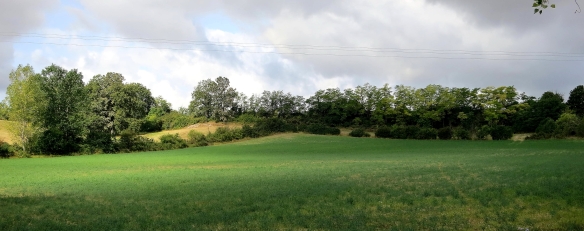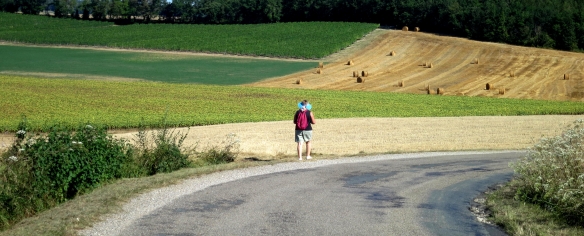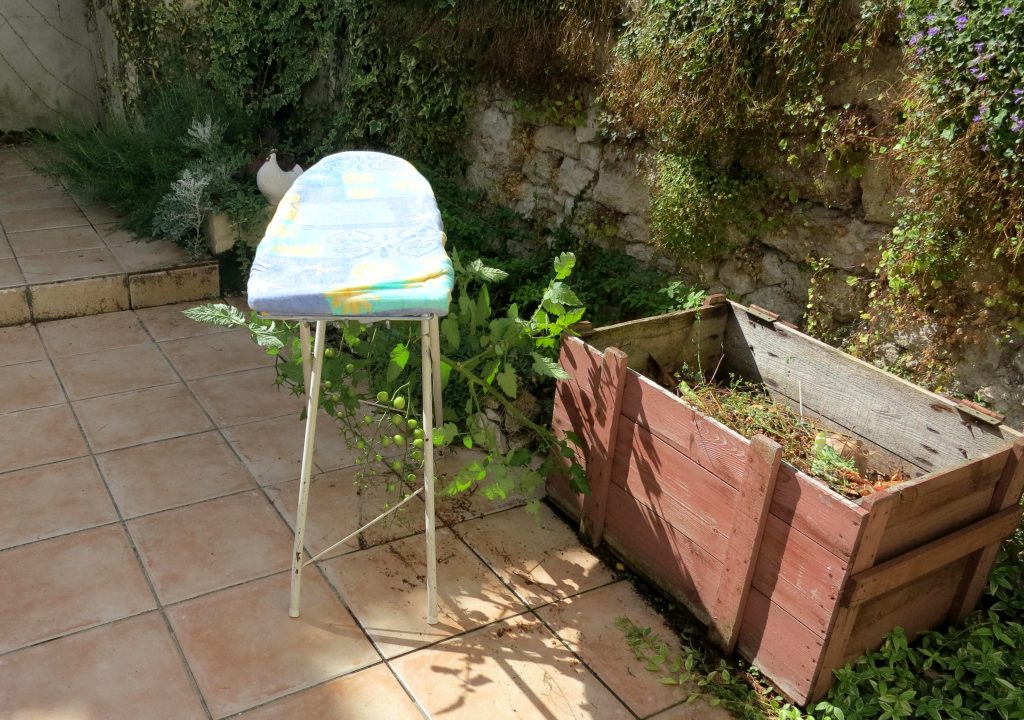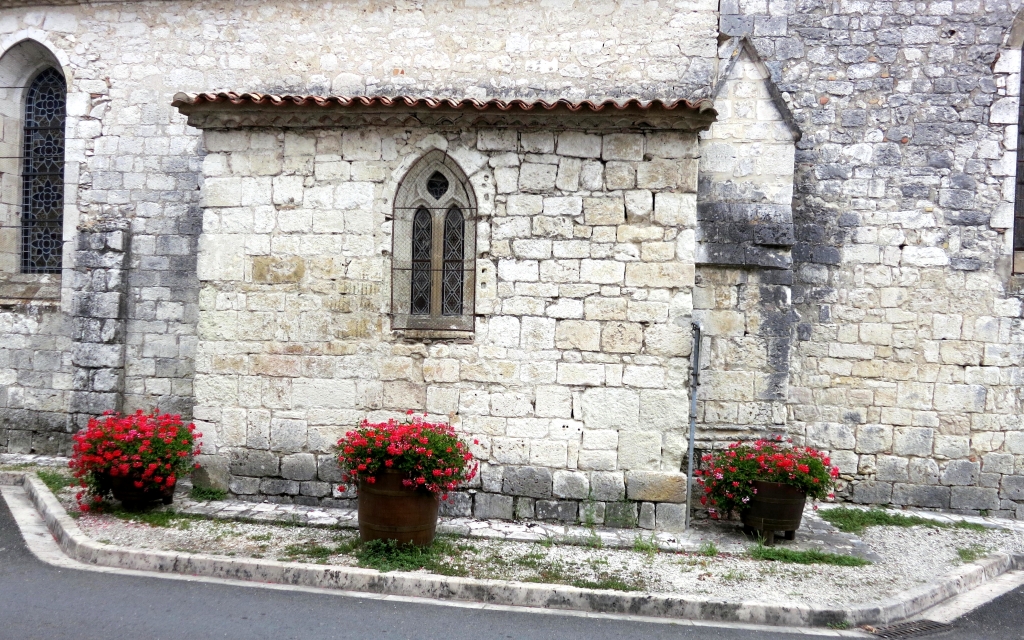This morning it was to Flaugeac and back that my feet took me.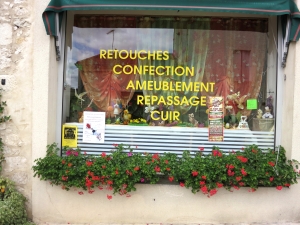 Once you have walked past the shops in rue de la Fon Close and up the hill past Les Caves there is not much of interest on the road to the D933, which, taking your life in your hands, you have to cross.
Once you have walked past the shops in rue de la Fon Close and up the hill past Les Caves there is not much of interest on the road to the D933, which, taking your life in your hands, you have to cross. This looks like a comparatively recent thoroughfare. Flora in the verges are not yet firmly established. I did go past the municipal dump, where, when I can obtain some wheels, I must take my defunct washing machine for its last rites. To the left, vines stretch down the slopes to sheep grazing in the valley below. To the right, their lines travel upwards until they meet the horizon.
This looks like a comparatively recent thoroughfare. Flora in the verges are not yet firmly established. I did go past the municipal dump, where, when I can obtain some wheels, I must take my defunct washing machine for its last rites. To the left, vines stretch down the slopes to sheep grazing in the valley below. To the right, their lines travel upwards until they meet the horizon.
Crossing the major road and approaching Flaugeac there are more signs of life. And one of death.  By a bend in the roadside, on the edge of a field, stands a small wooden cross decorated with plastic flowers and bulbs which presumably light up at night. I imagine this is similar to memorials at the sites of fatal accidents we see in England. I think of two such in Surrey. One was a lamppost which a bereaved grandmother kept adorned with fresh bouquets. Another is a spot where schoolgirls for some years held candlelit vigils in memory of one of their classmates. On a sharp bend in the road between Newark and Southwell in Nottinghamshire, a tree in a field close to the roadside bears a notice in memoriam to two teenagers who died there when their car crashed into it. Returning past the cemetery in Sigoules, I observed an elderly woman with a walking stick and a small plastic watering can, hobbling down the steep steps from the graveyard. I did not ask her her story, but speculated that she had been tending the resting place of a loved one. I thought again of those plastic flowers.
By a bend in the roadside, on the edge of a field, stands a small wooden cross decorated with plastic flowers and bulbs which presumably light up at night. I imagine this is similar to memorials at the sites of fatal accidents we see in England. I think of two such in Surrey. One was a lamppost which a bereaved grandmother kept adorned with fresh bouquets. Another is a spot where schoolgirls for some years held candlelit vigils in memory of one of their classmates. On a sharp bend in the road between Newark and Southwell in Nottinghamshire, a tree in a field close to the roadside bears a notice in memoriam to two teenagers who died there when their car crashed into it. Returning past the cemetery in Sigoules, I observed an elderly woman with a walking stick and a small plastic watering can, hobbling down the steep steps from the graveyard. I did not ask her her story, but speculated that she had been tending the resting place of a loved one. I thought again of those plastic flowers.
Before reaching the outskirts of my village, I noticed a man with a metal detector in a fallow field between two vineyards. Striding across to where he was prospecting, I heard regular alarms emanating from his machine. I asked him if he’d found anything. He said not. He followed this up with something I could not understand. Bending down, he picked up what I took to be a chip of stone bearing particles of metal. He said that was not the case, and showed me it was a metallic shard covered in chalky deposits. This had come from the vines. The rest was ‘lost in translation’. As I left, he thanked me. I’m not sure why. Perhaps just someone else who was grateful for interest. Yesterday’s vintage car enthusiast was shopping in Carrefour. Unfortunately he hadn’t driven down in his Austin.
The reflection of one of the new shutters alerted me to the fact that I have a framed Mondrian painting on my sitting room wall. Geoff Wilson was a most energetic Social Worker in my Area team in Westminster. Since he would always volunteer for night duty and work a full day afterwards, I swear he never slept. One day in the 1970s he did not turn up. A few days later he died of cancer. A complete surprise to everyone, probably including himself. We had a collection. His widow said she would like a painting to remember him by. Never having met her, with great trepidation, I took on the task of choosing one. I selected a landscape I liked myself, which I thought bland enough to be inoffensive. As soon as I entered the Wilson home I knew I could not have been more wrong. The house was full of much more striking pictures, none of which were to my taste. Bland would definitely not do. As she opened my parcelled offering, Mrs. Wilson said: ‘Oh no! That’s a nothing picture’. ‘I can see that.’ I replied, ‘Don’t worry, I was prepared for this. Now I know what you like, I will buy you another and keep this for myself.’ Very soon afterwards I returned with a brightly coloured Swiss mountain scene, complete with chalet. She was absolutely delighted. Given her previous reaction I was confident her joy was unfeigned. You can imagine my relief. Piet Mondrian used my original as a basis for the work that, at the right time of day, now adorns my wall.
Geoff Wilson was a most energetic Social Worker in my Area team in Westminster. Since he would always volunteer for night duty and work a full day afterwards, I swear he never slept. One day in the 1970s he did not turn up. A few days later he died of cancer. A complete surprise to everyone, probably including himself. We had a collection. His widow said she would like a painting to remember him by. Never having met her, with great trepidation, I took on the task of choosing one. I selected a landscape I liked myself, which I thought bland enough to be inoffensive. As soon as I entered the Wilson home I knew I could not have been more wrong. The house was full of much more striking pictures, none of which were to my taste. Bland would definitely not do. As she opened my parcelled offering, Mrs. Wilson said: ‘Oh no! That’s a nothing picture’. ‘I can see that.’ I replied, ‘Don’t worry, I was prepared for this. Now I know what you like, I will buy you another and keep this for myself.’ Very soon afterwards I returned with a brightly coloured Swiss mountain scene, complete with chalet. She was absolutely delighted. Given her previous reaction I was confident her joy was unfeigned. You can imagine my relief. Piet Mondrian used my original as a basis for the work that, at the right time of day, now adorns my wall.
In fact, I do have a genuine unknown masterpiece story. Jessica’s aunt and uncle, Jattie and Ronnie, had a picture on their wall in Farnham which had an unmistakeable style I instantly recognised. For several years, each time we visited them, I was drawn to the painting. I tried to convince myself I was wrong. For one thing I had only seen the artist’s work in reproduction, and did not know the scale of his creations. This little gem was surely much too small. It has the monumental quality one sees in Blake’s tiny illustrations.Yet, the beautiful young woman reclining on a garden bench was surely one of his models. And surely her long, striped dress was of the period. And surely it was his trademark to pay great attention to the detail of clothing. Not wishing to appear stupid, I never said anything. It niggled away at me, and I was not surprised when eventually someone else told them what they had. Unfortunately this frightened them and they sold it. I never feasted my eyes on it again. The painting was by Tissot. And just think of the Brownie points I could have won.
This afternoon, I continued reading Dennis Wheatley’s ‘Vendetta in Spain’. This evening I finished off the pork and sausage casserole I had shared with Don, and followed it with lemon sorbet ‘with bits in’.
